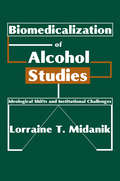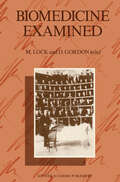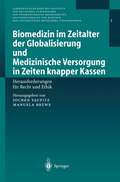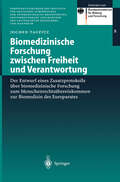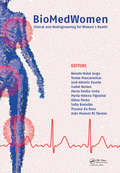- Table View
- List View
Biomedicalization of Alcohol Studies: Ideological Shifts and Institutional Challenges
by Lorraine MidanikBiomedicalization is seen as the natural outgrowth of continued scientific progress--a movement towards improving the quality and quantity of life through scientific inquiries using biomedical perspectives and methods. This approach carries with it the assumption that with "proper" risk assessment, detection, and treatment, our lives can be lengthened, improved, and indeed more fulfilling. Yet critics question biomedicalization's ability to deliver. There is concern about how biomedicalization can change our traditional concepts of health as we discover more conditions for which we are at risk, and health maintenance is seen as the responsibility of the individual.The purpose of the book is to describe, assess, and critique biomedicalization and its influence as a larger social trend on the health field and specifically in the area of alcohol research, policy, and programs. Chapter 1 gives a broad overview of biomedicalization. Chapter 2 lays the groundwork for a historical understanding of how medicalization and biomeidcalization have developed and are expressed in diverse fields such as aging, psychiatry/mental health, and women's health. Chapter 3 focuses in-depth on alcoholism and assesses the development and assumptions underlying the two movements that have greatly influenced the substance abuse field: the medicalization of deviance and the growth of the disease model of alcoholism. Chapter 4 discusses the origins and development of the National Institute on Alcohol Abuse and Alcoholism (NIAAA) from its inception in 1970. Chapter 5 illustrates the growing biomedicalization that has occurred in the alcohol field prior to NIAAA's movement to the National Institute of Health (NIH). Chapter 6 assesses how Sweden has handled alcohol problems and currently funds alcohol research. Chapter 7 concludes with a rationale for an expanded discourse between social scientists and biomedical researchers working on social problems, particularly alcohol issues.This volume will stimulate discussion of the processes by which social problems, and specifically alcohol issues, are framed, managed, and studied. It will hold particular interest for researchers and students in the areas of alcohol studies, social science, and social welfare. Lorraine Midanik is a professor in the School of Social Welfare, University of California, Berkeley.
Biomedicalization of Alcohol Studies: Ideological Shifts and Institutional Challenges
by Lorraine MidanikBiomedicalization is seen as the natural outgrowth of continued scientific progress--a movement towards improving the quality and quantity of life through scientific inquiries using biomedical perspectives and methods. This approach carries with it the assumption that with "proper" risk assessment, detection, and treatment, our lives can be lengthened, improved, and indeed more fulfilling. Yet critics question biomedicalization's ability to deliver. There is concern about how biomedicalization can change our traditional concepts of health as we discover more conditions for which we are at risk, and health maintenance is seen as the responsibility of the individual.The purpose of the book is to describe, assess, and critique biomedicalization and its influence as a larger social trend on the health field and specifically in the area of alcohol research, policy, and programs. Chapter 1 gives a broad overview of biomedicalization. Chapter 2 lays the groundwork for a historical understanding of how medicalization and biomeidcalization have developed and are expressed in diverse fields such as aging, psychiatry/mental health, and women's health. Chapter 3 focuses in-depth on alcoholism and assesses the development and assumptions underlying the two movements that have greatly influenced the substance abuse field: the medicalization of deviance and the growth of the disease model of alcoholism. Chapter 4 discusses the origins and development of the National Institute on Alcohol Abuse and Alcoholism (NIAAA) from its inception in 1970. Chapter 5 illustrates the growing biomedicalization that has occurred in the alcohol field prior to NIAAA's movement to the National Institute of Health (NIH). Chapter 6 assesses how Sweden has handled alcohol problems and currently funds alcohol research. Chapter 7 concludes with a rationale for an expanded discourse between social scientists and biomedical researchers working on social problems, particularly alcohol issues.This volume will stimulate discussion of the processes by which social problems, and specifically alcohol issues, are framed, managed, and studied. It will hold particular interest for researchers and students in the areas of alcohol studies, social science, and social welfare. Lorraine Midanik is a professor in the School of Social Welfare, University of California, Berkeley.
Biomedicine Examined (Culture, Illness and Healing #13)
by M. Lock D. GordonThe culture of contemporary medicine is the object of investigation in this book; the meanings and values implicit in biomedical knowledge and practice and the social processes through which they are produced are examined through the use of specific case studies. The essays provide examples of how various facets of 20th century medicine, including edu cation, research, the creation of medical knowledge, the development and application of technology, and day to day medical practice, are per vaded by a value system characteristic of an industrial-capitalistic view of the world in which the idea that science represents an objective and value free body of knowledge is dominant. The authors of the essays are sociologists and anthropologists (in almost equal numbers); also included are papers by a social historian and by three physicians all of whom have steeped themselves in the social sci ences and humanities. This co-operative endeavor, which has necessi tated the breaking down of disciplinary barriers to some extent, is per haps indicative of a larger movement in the social sciences, one in which there is a searching for a middle ground between grand theory and attempts at universal explanations on the one hand, and the context-spe cific empiricism and relativistic accounts characteristic of many historical and anthropological analyses on the other.
Biomedicine, Healing and Modernity in Rural Bangladesh
by Md. Faruk ShahThis book provides an ethnographic account of the ways in which biomedicine, as a part of the modernization of healthcare, has been localized and established as the culturally dominant medical system in rural Bangladesh. Dr Faruk Shah offers an anthropological critique of biomedicine in rural Bangladesh that explains how the existing social inequalities and disparities in healthcare are intensified by the practices undertaken in biomedical health centres through the healthcare bureaucracy and local gendered politics. This work of villagers’ healthcare practices leads to a fascinating analysis of the local healthcare bureaucracy, corruption, structural violence, commodification of health, pharmaceutical promotional strategies and gender discrimination in population control. Shah argues that biomedicine has already achieved cultural authority and acceptability at almost all levels of the health sector in Bangladesh. However, in this system healthcare bureaucracy is shaped by social capital, power relations and kin networks, and corruption is a central element of daily care practices.
Biomedizin im Zeitalter der Globalisierung und Medizinische Versorgung in Zeiten knapper Kassen: Herausforderungen für Recht und Ethik (Veröffentlichungen des Instituts für Deutsches, Europäisches und Internationales Medizinrecht, Gesundheitsrecht und Bioethik der Universitäten Heidelberg und Mannheim #1)
by Jochen Taupitz Manuela BreweIm Sommersemester 1999 veranstaltete das Institut für Deutsches, Europäisches und Internationales Medizinrecht, Gesundheitsrecht und Bioethik (IMGB) eine eigenständigen Vortragsreihe zu dem Thema "Medizinische Versorgung in Zeiten knapper Kassen". In sieben Vorträgen setzen sich Referenten aus Wissenschaft und Praxis mit dem aktuellen Problem der Ressourcenknappheit und Ressourcenverteilung im Gesundheitswesen auseinander. Die Beiträge spannen einen weiten Bogen von philosophischen, gesellschaftspolitischen, ökonomischen und juristischen Grundfragen bis hin zu ganz praktischen Problemen in der Organisation der gesetzlichen Krankenversicherungen und bei der Tätigkeit des Arztes "vor Ort".
Biomedizin und Ethik: Praxis — Recht — Moral
by Werner Arber Hans-Peter SchreiberDer rasante Erkenntnisgewinn der letzten Jahrzehnte über Entstehung und Verlauf vieler Erkrankungen stellt unser Wissen auf eine neue Grundlage und eröffnet viel versprechende Entwicklungsmöglichkeiten präventiver und diagnostischer Verfahren und Therapien. Gleichzeitig dringt diese Forschung in Bereiche vor, die das Grundverständnis vom Menschsein tangieren, und uns zwingt, jene Begriffe neu zu überdenken, die für unser menschliches Selbstverständnis essentiell sind. An welchen normativen Kriterien sollen wir uns orientieren, um zwischen moralisch vertretbaren und moralisch verwerflichen Technikanwendungen sinnvoll unterscheiden zu können? Renommierte Beitragsautoren nehmen Stellung zu Themen, die anthropologische, ethische, rechtliche, kulturelle und soziale Fragen erzeugen: ethische und sozialpolitische Implikationen neuer molekulargenetischer Diagnostikverfahren; Perspektiven und Folgen von Klonierungstechniken; moralische und grundrechtliche Fragen der Embryonen- und Stammzellforschung; ethische Kritikpunkte hinsichtlich Patentschutz biotechnologischer Erfindungen. Ein wichtiger Beitrag zur aktuellen Bioethik-Debatte.
Biomedizinische Forschung zwischen Freiheit und Verantwortung: Der Entwurf eines Zusatzprotokolls über biomedizinische Forschung zum Menschenrechtsübereinkommen zur Biomedizin des Europarates (Veröffentlichungen des Instituts für Deutsches, Europäisches und Internationales Medizinrecht, Gesundheitsrecht und Bioethik der Universitäten Heidelberg und Mannheim #8)
by Jochen TaupitzSeit 1997 liegt das "Menschenrechtsübereinkommen zur Biomedizin" des Europarates vor, das inzwischen von 11 Mitgliedstaaten des Europarates ratifiziert wurde. Zu diesem Übereinkommen wurde nunmehr der Entwurf eines Zusatzprotokolls über biomedizinische Forschung zur öffentlichen Diskussion in den Mitgliedstaaten freigegeben. Die hier vorgelegte Untersuchung, die aus einem Gutachten im Auftrag des BMBF hervorgegangen ist, unterzieht den Entwurf des Forschungsprotokolls einer kritischen Würdigung, um zu klären, inwieweit die Bestimmungen des Forschungsprotokolls mit dem deutschen und europäischen Recht sowie dem Völkerrecht vereinbar sind. Darüber hinaus sollen Anregungen für Verbesserungen des Entwurfs gegeben werden. Nicht zuletzt steht im Hintergrund die Frage, ob Deutschland dem Forschungsprotokoll später beitreten sollte. Die Untersuchung kommt zu dem Ergebnis, daß der Entwurf in mehrfacher Hinsicht modifizierungsbedürftig ist.
Biomedizinische Nanomaterialien: Vom Design und der Synthese bis hin zu Bildgebung, Anwendung und Umweltauswirkungen
by Rostyslav S. StoikaIn diesem Buch wird beschrieben, wie Nanomaterialien organischer und mineralischer Natur entworfen und synthetisiert werden können. Das Buch behandelt auch die Visualisierung der entwickelten Nanomaterialien und ihre Bioanwendungen und beschreibt die biomedizinischen Wirkungen und Umweltauswirkungen von Nanomaterialien.Es ist ein ideales Buch für Studenten der Biomedizin oder der Biowissenschaften sowie für Forscher und Fachleute in den Bereichen Medizin, Umweltschutz, Biotechnologie, Landwirtschaft und Lebensmittelindustrie. Dieses Buch befasst sich insbesondere mit den wichtigen Nanomaterialien und Nanobiotechnologien, die in diesen Bereichen der Biomedizin und der Biowissenschaften eingesetzt werden.
Biomedizinische Technik 1991: Betrachtungen zur Situation eines multidisziplinären Fachgebietes
by Helmut HuttenInhalt: Einleitung. - Die Entwicklung der Biomedizinischen Technik. - Biomedizinische Technik (BMT), Medizintechnik (MT), Biomedical Engineering (BME). - Einflu~faktoren auf die Biomedizinische Technik. - Die Forschungsf|rderung. - Fachgesellschaften mit Bezug zur BMT. - BMT im Bereich der wissenschaftlichen Einrichtungen. - Die BMT im Umfeld der Industrie. - Biomedizinische Technik im internationalen Vergleich. -BME in der Europ{ischen Gemeinschaft. - Zusammenfassung und Empfehlungen.
Biomedizinische Technik 4: Technische Sondergebiete
by Helmut HuttenDie Medizin bedient sich in der Diagnostik und Therapie in zunehmendem Maße physikalisch-technischer Verfahren. Aus dieser Entwicklung ergibt sich ein wachsender Bedarf an qualifizierten Ingenieuren und Physikern, die in Kliniken und an Forschungsinstitutionen den Einsatz von Technik in der Medizin organisieren und überwachen. Das vierbändige Lehr- und Handbuch behandelt in umfassender Weise das Gesamtgebiet der biomedizinischen Technik. 57 Autoren von Universitäten, Forschungsinstituten, Kliniken und der Industrie haben erstmals in deutscher Sprache ein Werk geschaffen, das alle Voraussetzungen zu einem Standardwerk auf dem Gebiet erfüllt. Band 4 beschreibt Sondergebiete wie Mikroskope, Endoskope, Laser, Strahlenschutz, Meßwertwandler, Biomaterialien, Ergonomie und elektromagnetische Verträglichkeit. Ein Kapitel über Rechtsvorschriften und Normen runden den Band ab. Die weiteren Bände behandeln Diagnostik und bildgebende Verfahren (Band 1), Therapie und Rehabilitation (Band 2) sowie Signal- und Datenverarbeitung und Medizinische Sondergebiete (Band 3).
BioMedWomen: Proceedings of the International Conference on Clinical and BioEngineering for Women's Health (Porto, Portugal, 20-23 June, 2015)
BioMedWomen 2015 - Clinical and BioEngineering for Women´s Health contains all author contributions presented at BioMedWomen 2015 (Porto, Portugal, 20–23 June 2015). International contributions from countries worldwide provided comprehensive coverage of the current state-of-the-art on different topics: • Aging • Physical Activity and Sports • Physiotherapy • Aesthetic and Reconstructive Surgery • Urogynecology • Imaging • Biomechanics • Nutrition • Health Psychology • Assisted diagnosis and Treatment • Tissue Engineering • Medical Devices • Prosthesis • Dental care and Orthodontics BioMedWomen 2015 - Clinical and BioEngineering for Women´s Health will be of interest to academics and to others interested and involved in clinical and engineering subjects related to women´s health.
Biomembrane Simulations: Computational Studies of Biological Membranes (Series in Computational Biophysics)
by Max L. BerkowitzDue to recent advancements in the development of numerical algorithms and computational hardware, computer simulations of biological membranes, often requiring use of substantial computational resources, are now reaching a mature stage. Since molecular processes in membranes occur on a multitude of spatial and time scales, molecular simulations of membranes can also serve as a testing ground for use of multi-scale simulation techniques. This book addresses some of the important issues related to understanding properties and behavior of model biological membranes and it Shows how simulations improve our understanding of biological membranes and makes connections with experimental results. Presents a careful discussion of the force fields used in the membrane simulations including detailed all-atom fields and coarse-grained fields. Presents a continuum description of membranes. Discusses a variety of issues such as influence of membrane surfaces on properties of water, interaction between membranes across water, nanoparticle permeation across the membrane, action of anesthetics and creation of inhomogeneous regions in membranes. Discusses important methodological issues when using simulations to examine phenomena such as pore creation and permeation across membranes. Discusses progress recently achieved in modeling bacterial membranes. It will be a valuable resource for graduate students, researchers and instructors in biochemistry, biophysics, pharmacology, physiology, and computational biology.
Biomembrane Simulations: Computational Studies of Biological Membranes (Series in Computational Biophysics)
by Max L. BerkowitzDue to recent advancements in the development of numerical algorithms and computational hardware, computer simulations of biological membranes, often requiring use of substantial computational resources, are now reaching a mature stage. Since molecular processes in membranes occur on a multitude of spatial and time scales, molecular simulations of membranes can also serve as a testing ground for use of multi-scale simulation techniques. This book addresses some of the important issues related to understanding properties and behavior of model biological membranes and it Shows how simulations improve our understanding of biological membranes and makes connections with experimental results. Presents a careful discussion of the force fields used in the membrane simulations including detailed all-atom fields and coarse-grained fields. Presents a continuum description of membranes. Discusses a variety of issues such as influence of membrane surfaces on properties of water, interaction between membranes across water, nanoparticle permeation across the membrane, action of anesthetics and creation of inhomogeneous regions in membranes. Discusses important methodological issues when using simulations to examine phenomena such as pore creation and permeation across membranes. Discusses progress recently achieved in modeling bacterial membranes. It will be a valuable resource for graduate students, researchers and instructors in biochemistry, biophysics, pharmacology, physiology, and computational biology.
BioMEMS: Science and Engineering Perspectives
by Simona BadilescuAs technological advancements widen the scope of applications for biomicroelectromechanical systems (BioMEMS or biomicrosystems), the field continues to have an impact on many aspects of life science operations and functionalities. Because BioMEMS research and development require the input of experts who use different technical languages and come f
BioMEMS: Science and Engineering Perspectives
by Simona Badilescu Muthukumaran PackirisamyAs technological advancements widen the scope of applications for biomicroelectromechanical systems (BioMEMS or biomicrosystems), the field continues to have an impact on many aspects of life science operations and functionalities. Because BioMEMS research and development require the input of experts who use different technical languages and come f
BioMEMS: Biosensing Applications (Lecture Notes in Bioengineering)
by Samira Hosseini Michelle Alejandra Espinosa-Hernandez Ricardo Garcia-Ramirez Ana Sofia Cerda-Kipper Sofia Reveles-Huizar Luis Acosta-SotoThis book highlights the latest advances in bioMEMS for biosensing applications. It comprehensively reviews different detection methods, including colorimetric, fluorescence, luminescence, bioluminescence, chemiluminescence, biochemiluminescence, and electrochemiluminescence, and presents various bioMEMS for each, together with recent examples. The book also offers an overview of the history of BioMEMS and the design and manufacture of the first bioMEMS-based devices.
BioMEMS (Microsystems #16)
by Gerald UrbanExplosive growth in the field of microsystem technology (MST) has introduced a variety of promising products in major disciplines from microelectronics to life sciences. Especially the life sciences and health care business was, and is expected to be a major market for MST products. Undoubtedly the merging of biological sciences with micro- and nanoscience will create a scientific and technological revolution in future. Microminiaturization of devices, down to the nanoscale, approaching the size of biological structures, will be a prerequisite for the future success of life sciences. Bioanalytical and therapeutic micro- and nanosystems will be mandatory for system biologists in the long run, to obtain insight into morphology, the function and the interactive processes of the living system. With such a deeper understanding new and personalized drugs could be developed leading to a revolution in life sciences. Today, microanalytical devices are used in clinical analytics or molecular biology as gene chips. In parallel, standard microbiomedical products are employed in the intensive care and surgical theatre, mainly for monitoring and implantation purposes. The gap between these two different scientific fields will be closed, however, as soon as functional micro devices can be produced, allowing a deeper view into the function of cells and whole organisms. Here, a new discipline evolved which focuses on microsystems for living systems called "BIOMEMS". In this review at a glance the exciting field of bio-microsystems, from their beginnings to indicators of future successes are presented. It will also show that a broad penetration of micro and nano technologies into biology and medicine will be mandatory for future scientific and new product development progress in life science.
BioMEMS and Biomedical Nanotechnology: Volume IV: Biomolecular Sensing, Processing and Analysis (Biomems And Biomedical Nanotechnology Ser.)
by Mauro FerrariBioMEMS and Biomedical Nanotechnology: Volume I: Biological and Biomedical Nanotechnology
by Mauro Ferrariblends materials, fabrication, and structure issues of developing nanobio devices in a single volume. treats major nanobio application areas such as drug delivery, molecular diagnostics, and imaging. chapters written by the leading researchers in the field.
BioMEMS and Biomedical Nanotechnology: Volume II: Micro/Nano Technologies for Genomics and Proteomics (Biomems And Biomedical Nanotechnology Ser.)
by Mauro FerrariBioMEMS and Biomedical Nanotechnology: Volume III: Therapeutic Micro/Nanotechnology (Biomems And Biomedical Nanotechnology Ser.)
by Mauro FerrariBiometals in Autism Spectrum Disorders
by Andreas GrabruckerBiometals in Autism Spectrum Disorders focuses on trace metals and autism. Compared to other references examining ASDs or metallomics, this book presents findings of abnormal metal homeostasis in ASD, providing an overview of current findings on trace metal biology, its role in ASD etiology, and how abnormal trace metal biology may be a common factor of several genetic and non-genetic causes of ASDs that were once considered unrelated. This comprehensive resource opens new vistas for the development of new therapies based on the targeted manipulation of trace metal homeostasis that will generate new awareness surrounding trac metal levels during pregnancy.Reviews the role of trace metals in brain developmentSummarizes research linking trace metals and autismExplores heterogenous phenotypes as a factor of genetic and non-genetic factorsIncludes animal and human stem researchContains many useful diagrams, tables and flow chartsProposes future therapies based on biometal homeostasis
Biometals in Neurodegenerative Diseases: Mechanisms and Therapeutics
by Lucio G. Costa Anthony R. White Ashley I. BushBiometals in Neurodegenerative Diseases: Mechanisms and Therapeutics is an authoritative and timely resource bringing together the major findings in the field for ease of access to those working in the field or with an interest in metals and their role in brain function, disease, and as therapeutic targets. Chapters cover metals in Alzheimer’s Disease, Parkinson’s Disease, Motor Neuron Disease, Autism and lysosomal storage disorders. This book is written for academic researchers, clinicians and advanced graduate students studying or treating patients in neurodegeneration, neurochemistry, neurology and neurotoxicology. The scientific literature in this field is advancing rapidly, with approximately 300 publications per year adding to our knowledge of how biometals contribute to neurodegenerative diseases. Despite this rapid increase in our understanding of biometals in brain disease, the fields of biomedicine and neuroscience have often overlooked this information. The need to bring the research on biometals in neurodegeneration to the forefront of biomedical research is essential in order to understand neurodegenerative disease processes and develop effective therapeutics. Authoritative and timely resource bringing together the major findings in the field for those with an interest in metals and their role in the brain function, disease, and as therapeutic targetsWritten for academic researchers, clinicians, and advanced graduate students studying, or treating, patients in neurodegeneration, neurochemistry, neurology and neurotoxicologyEdited by international leaders in the field who have contributed greatly to the study of metals in neurodegenerative diseases
Biometrie (XStudienbücher Medizinische Informatik)
by Lutz DümbgenDas Buch gibt eine Einführung in die wichtigsten statistischen Methoden und Denkweisen. Dabei werden insbesondere Verfahren behandelt, die auch in der Biostatistik zum Einsatz kommen, z. B. Verfahren rund um randomisierte Studien und Vierfeldertafeln. Neben klassischen Methoden werden auch rechenintensive Verfahren wie z. B. exakte Konfidenzschranken oder Bootstrap/Resampling-Methoden beschrieben.
